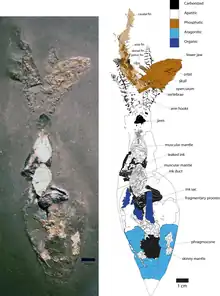Clarkeiteuthis
Clarkeiteuthis is a genus of extinct belemnoid cephalopod known from the lower Jurassic in Germany and England. Described two species, C. conocauda and C. montefiorei are originally described as species of phragmoteuthid Phragmoteuthis, but got their own genus and moved to Diplobelida.[1]
| Clarkeiteuthis Temporal range: Sinemurian to Toarcian | |
|---|---|
 | |
| Fossil of Clarkeiteuthis conocauda preying on Leptolepis | |
| Scientific classification | |
| Domain: | Eukaryota |
| Kingdom: | Animalia |
| Phylum: | Mollusca |
| Class: | Cephalopoda |
| Order: | †Diplobelida |
| Genus: | †Clarkeiteuthis Dirk et al. 2013 |
| Species | |
| |
| Synonyms | |
|
Synonyms of C. conocauda
Synonyms of C. montefiorei
| |
Description

Two species are described, C. conocauda is known from Posidonia Shale, and C. montefiorei is known from Charmouth Mudstone Formation.
Clarkeiteuthis had long phragmocone and ten short, hook-bearing arms.[1] Although it is originally considered as phragmoteuthid, this classification has been discussed by modern researchers, as it lacked a broad three-lobed proostracum (The anterior prolongation of the guard of the phragmocone), the autapomorphy of phragmoteuthid.
C. conocauda had total length about 21 cm (8.3 in). This species is well preserved, soft tissues such as mantle and ink sac are visible. One arm had around 30 hooks.[2]
Palaeobiology

Well-preserved specimens of C. conocauda with Leptolepis bronni (invalid species of Leptolepis[3]) in its arms are known from Posidonia Shale. Preservation of fossil and behavior of living cephalopod suggests that Clarkeiteuthis probably contracted its arms to pull prey towards its mouth to cut the spine by using its beaks, and then feed on it. In all the three specimens of C. conocauda with catching preys had Leptolepis in its arms. Leptolepis is most common fish in the formation, and it lacked thick scales, so it was probably the most common prey of Clarkeiteuthis.[2]
Unlike belemnites which are considered as good swimmers, diplobelids like Clarkeiteuthis were probably less active swimmers, with the capability of occasional short bursts of rapid swimming movements.[2]
References
- Fuchs, Dirk; Donovan, Desmond T.; Keupp, Helmut (2013-12-01). "Taxonomic revision of ?Onychoteuthis? conocauda Quenstedt, 1849 (Cephalopoda: Coleoidea)". Neues Jahrbuch für Geologie und Paläontologie - Abhandlungen. 270 (3): 245–255. doi:10.1127/0077-7749/2013/0368.
- Jenny, Dominique; Fuchs, Dirk; Arkhipkin, Alexander I.; Hauff, Rolf B.; Fritschi, Barbara; Klug, Christian (2019-05-28). "Predatory behaviour and taphonomy of a Jurassic belemnoid coleoid (Diplobelida, Cephalopoda)". Scientific Reports. 9 (1): 7944. doi:10.1038/s41598-019-44260-w. ISSN 2045-2322. PMC 6538661. PMID 31138838.
- Konwert, M.; Stumpf, S. (2017). "Exceptionally preserved Leptolepidae (Actinopterygii, Teleostei) from the late Early Jurassic Fossil-Lagerstätten of Grimmen and Dobbertin (Mecklenburg-Western Pomerania, Germany)". Zootaxa. 4243 (2): 249–296. doi:10.11646/zootaxa.4243.2.2. PMID 28610149.